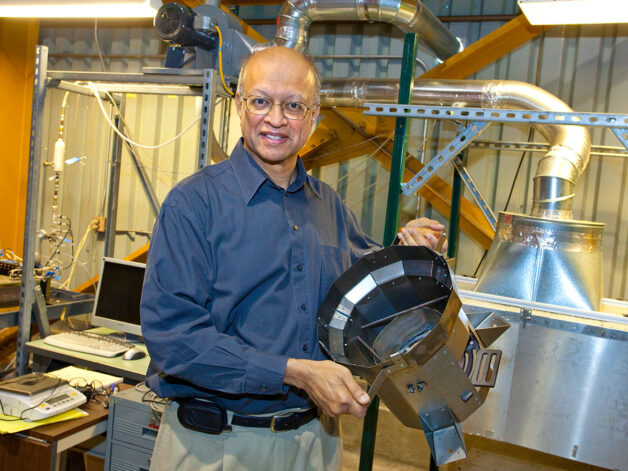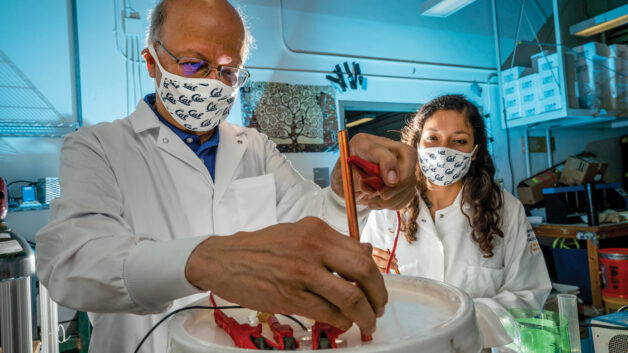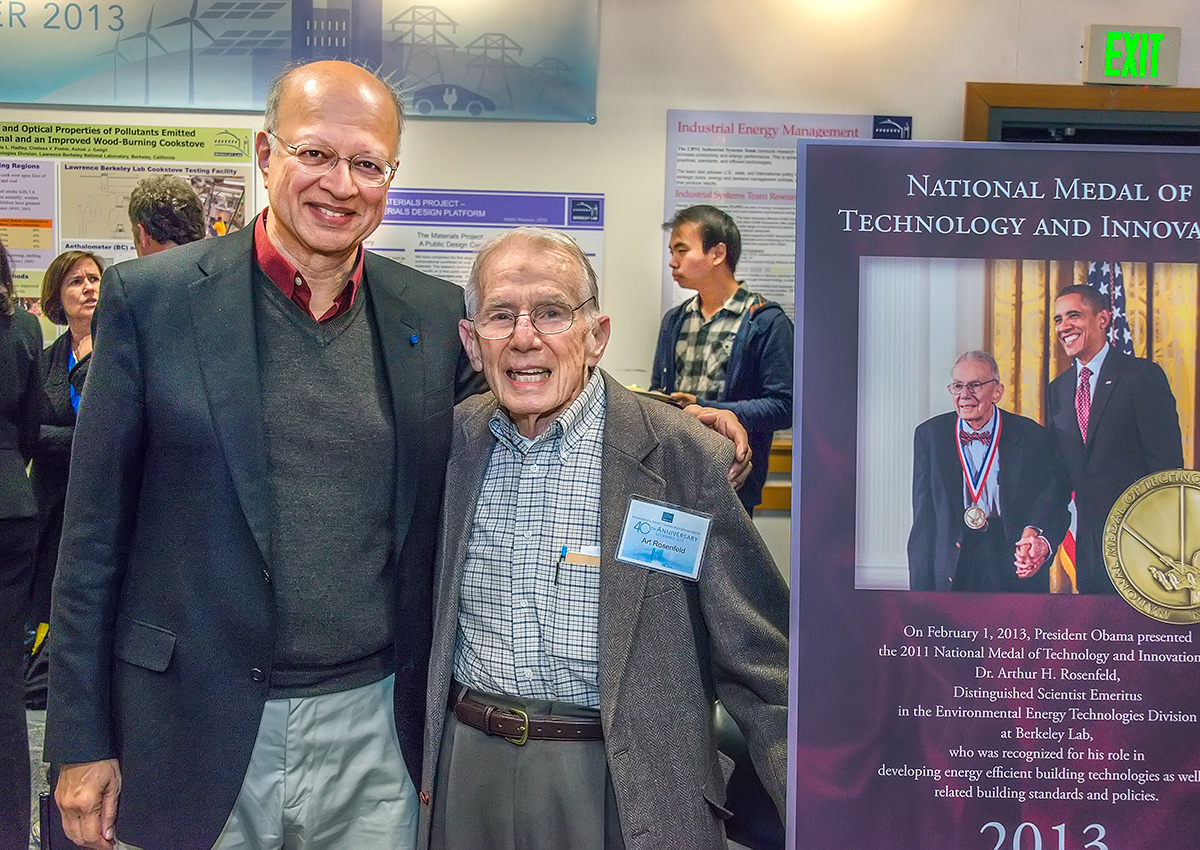During a ceremony at the White House today, President Biden awarded Lawrence Berkeley National Laboratory (Berkeley Lab) retired Faculty Senior Scientist Ashok Gadgil the National Medal of Technology and Innovation, the nation’s highest honor for technological achievement. His award is “for providing life-sustaining resources to communities around the world. His innovative, inexpensive technologies help meet profound needs from drinking water to fuel efficient cookstoves. His work is inspired by a belief in the dignity of all people and in our power to solve the great challenges of our time.” The award is bestowed by the president of the United States on America’s leading innovators.
In today’s announcement, President Biden named Gadgil one of 12 recipients of the medal.
Ashok’s award is the 17th national medal overall, and the 2nd National Medal of Technology and Innovation, Berkeley Lab researchers have earned.
Gadgil, who is also a Distinguished Professor Emeritus of Civil and Environmental Engineering at UC Berkeley, has developed low-cost solutions to some of the developing world’s most intractable problems, including safe drinking water technologies, energy efficient stoves, and ways to make efficient electric lighting affordable. He focuses on robust inventions that can be deployed as widely as possible, and together his projects have helped more than 100 million people. Gadgil is also an expert in building energy efficiency and computational fluid dynamics of indoor air and pollutant flows.
“Ashok’s decades-long commitment to developing technologies that address urgent humanitarian crises epitomizes Berkeley Lab’s mission of bringing science solutions to the world,” said Berkeley Lab Director Mike Witherell.
Gadgil and his colleagues have many inventions to their credit, but he is perhaps best known for three transformative technologies:
Low-cost, portable, energy-efficient water purifier

Gadgil with the UV Waterworks technology in 1996. (Credit: Steve Adams)
UV Waterworks was originally conceived in response to a 1993 cholera epidemic in South and Southeast Asia. It uses UV light from a low pressure mercury discharge (similar to that in a fluorescent lamp) to disinfect drinking water. The system has no moving parts and only requires 60 watts of power for the bulb and a fail-safe mechanism. It can disinfect approximately 4 gallons per minute, or one person’s entire water needs for an entire year at a cost of a couple of dimes. WaterHealth International, the licensee, currently operates in India, Bangladesh, Liberia, Nigeria, and Ghana. In 2017, it was serving more than 7 million consumers in these five countries.
Fuel-efficient, safer cookstoves for refugees

Gadgil at the Darfur Stove testing facility at Berkeley Lab in 2009. (Credit: Berkeley Lab)
In 2004, USAID requested Gadgil’s help to reduce the incidences of violence against refugee women in Darfur when they left the safety of the camps to collect firewood. The result, the Berkeley-Darfur Stove, is a highly efficient wood burning stove that is two to three times more efficient than traditional three-stone fires used by the refugees and many communities in Africa. This means that women using these stoves have to spend considerably less time gathering firewood for cooking; it consequently reduces their hardship, and for the refugee women reduces the risks of being attacked while far from their camps. Potential Energy, the non-profit licensee, has built and distributed more than 60,000 stoves so far, helping about 500,000 refugee family members in Darfur, Uganda, and elsewhere.
Arsenic removal technology for safe drinking water

Gadgil and Ph.D. student Dana Hernandez, right, test ECAR at Gadgil’s UC Berkeley lab in 2020. (Credit: Adam Lau/UC Berkeley College of Engineering)
ECAR (ElectroChemical Arsenic Removal) is a technology that removes toxic levels of arsenic from groundwater in South Asia and elsewhere. It uses small amounts of electricity to release a particular kind of iron rust in water that is contaminated with arsenic. The rust binds irreversibly with the arsenic and can be removed by settling, leaving the water safe to drink. The process is highly effective even at high levels of arsenic in groundwater. The pilot plant that Gadgil and his team built in India in 2017 serves arsenic safe water to about 5,000 people, selling it to them for 1 cent per liter, which covers all costs including salaries and a business margin. The Indian licensee, Livpure, built a second plant in 2021 of similar capacity. The arsenic filter displayed here is a more advanced version of ECAR also invented by Gadgil and his team in 2019, which has several thousand times higher throughput than the earlier ECAR technology. Gadgil and his team expect to pilot this advanced technology in California’s Central Valley starting in late 2024.
In addition, Gadgil innovated utility-financed efficient-lighting programs that have been successfully implemented in 38 countries in Eastern Europe, Asia, Africa, and Latin America. Gadgil also helped develop an infant warming device that does not require electricity, and is low-cost, convenient, and reusable. In a large randomized control trial in public hospitals in Rwanda, this technology lowered all-cause mortality rates of newborns by a factor of three, an impact that surprised even the research team.
Among his many honors, in 2014, Gadgil was inducted into the National Inventor’s Hall of Fame for work that “helped over 100 million people across four continents by making efficient electric lighting affordable, water safe to drink, and designing energy efficient stoves.” He also received the Heinz Award and the Lemelson-MIT Award for Global Innovation.
Gadgil received his PhD in physics from UC Berkeley in 1979. His early research at Berkeley Lab was inspired by his graduate advisor Art Rosenfeld, a pioneer in energy efficiency. Rosenfeld, who passed away in 2017, is a 2011 laureate of the National Medal of Technology and Innovation.

The National Medal of Technology and Innovation was created by statute in 1980 and is administered for the White House by the U.S. Department of Commerce’s Patent and Trademark Office. The award recognizes those who have made lasting contributions to America’s competitiveness and quality of life and helped strengthen the Nation’s technological workforce. A distinguished independent committee representing the private and public sectors submits recommendations to the President.
###
Lawrence Berkeley National Laboratory (Berkeley Lab) is committed to delivering solutions for humankind through research in clean energy, a healthy planet, and discovery science. Founded in 1931 on the belief that the biggest problems are best addressed by teams, Berkeley Lab and its scientists have been recognized with 16 Nobel Prizes. Researchers from around the world rely on the Lab’s world-class scientific facilities for their own pioneering research. Berkeley Lab is a multiprogram national laboratory managed by the University of California for the U.S. Department of Energy’s Office of Science.
DOE’s Office of Science is the single largest supporter of basic research in the physical sciences in the United States, and is working to address some of the most pressing challenges of our time. For more information, please visit energy.gov/science.
